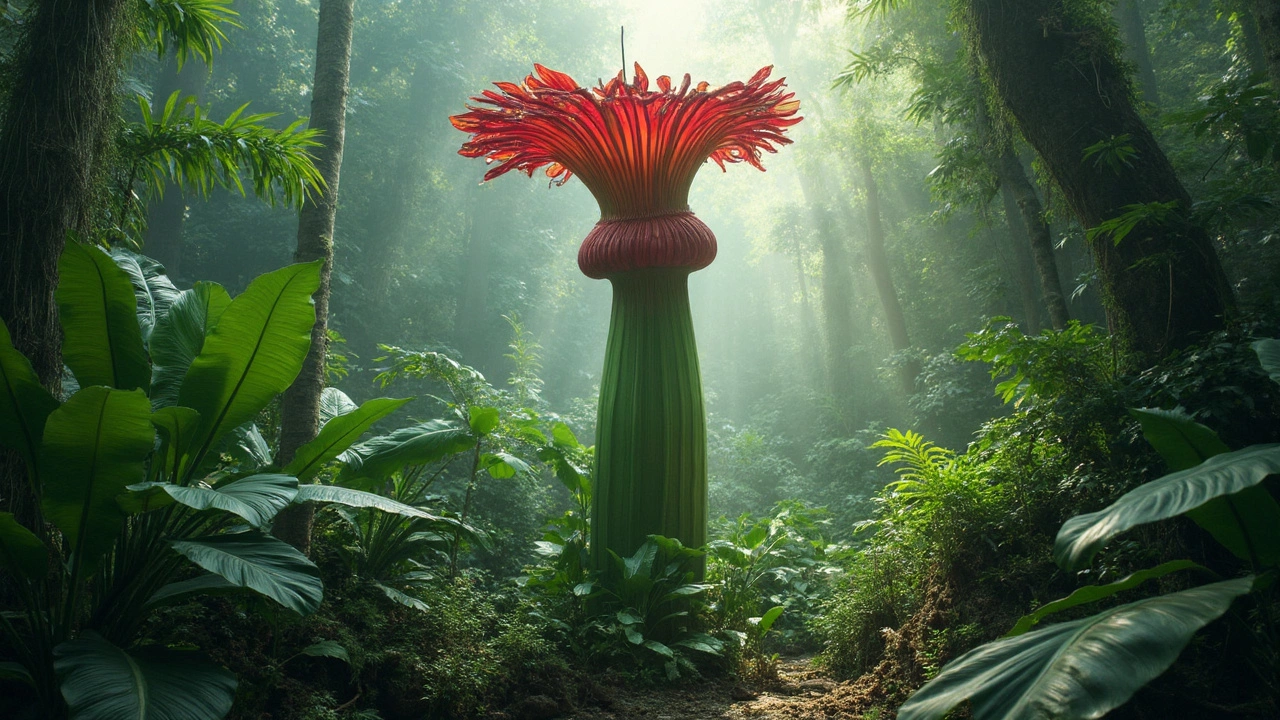Ever come across a flower that's more notorious for its smell than its beauty? Let me introduce you to the Titan Arum, also known as the 'corpse flower.' This peculiar plant is renowned for its odor that eerily resembles a decaying body. Why would any flower produce such a scent? It's all about nature's clever tricks to attract pollinators. Flies and beetles, which are drawn to the smell of rotting flesh, are the usual visitors, helping the plant in its pollination process.
Despite its less-than-pleasant aroma, the Titan Arum is a true spectacle when it blooms. Native to Sumatra, Indonesia, this towering plant can reach heights of over three meters—it’s like the basketball player of the plant world. But here's the catch: it can take years for the flower to finally blossom, often surprising with its sudden and short-lived bloom that's as rare as it is captivating.
- Introduction to the Corpse Flower
- Why Does It Smell?
- Growing Conditions for Titan Arum
- When and Where to See It Bloom
- Gardening Tips for Titan Arum
- Interesting Facts about Corpse Flowers
Introduction to the Corpse Flower
The corpse flower, officially named Amorphophallus titanum, is a plant that sparks curiosity and astonishment worldwide. Known for its legendary fragrance resembling a dead body, this flower is one of nature's most intriguing spectacles. Despite its off-putting scent, the titan arum draws crowds with its sheer size and dramatic appearance. Standing at over three meters when fully grown, it’s an unforgettable sight that few get to experience firsthand.
Native to Indonesia’s lush rainforest on the island of Sumatra, the corpse flower thrives in warm, humid conditions. It's no surprise that replicating these conditions for flower gardening in India makes it a challenging yet achievable venture. The plant is part of the Araceae family, a group that includes other tropical giants like the calla lily and peace lily, though none match the Titan in terms of both size and smell.
Blooming Cycle and Rarity
One of the most fascinating aspects of the corpse flower is its irregular blooming cycle. Unlike your average garden flower, the Titan Arum blooms infrequently, sometimes only once every seven to ten years. This rarity adds to its allure, making each bloom a significant event in rotundas and gardens worldwide.
What's particularly unique about its bloom is the buildup. The plant remains dormant for several months, with the underground tuber storing energy until conditions are just right. When it decides to bloom, it can all happen rather quickly, spanning only 24 to 48 hours. This short window makes it a must-see for enthusiasts.
Reproduction and the Unfolding Bloom
Pollination is critical for the titan arum to reproduce. During its bloom, the flower emits heat to help spread its notorious odor, attracting insects that thrive on decaying matter. Flies and beetles become unwitting carriers of pollen. Timing is everything, as the male and female parts of the flower are receptive at different times to avoid self-pollination. This synchronization is a marvel of evolutionary design.
Intrigued by this botanical phenomenon? The corpse flower is not just about its fragrance or size—it’s a testament to the adaptability and mystery of nature. Perfecting the growth conditions to see one bloom is no small feat, but the reward of witnessing its large, vibrant flower emerge is well worth the effort.
Why Does It Smell?
So why on earth would a flower like the corpse flower emit such a ghastly stench? It all comes down to survival and reproduction strategies. In the world of plants, the Titan Arum has developed a peculiar method to lure pollinators by mimicking the smell of decomposing flesh. This odor, unpleasant to us but irresistible to certain insects, is a beacon for those beetles and flies that feast on dead animals.
The Science Behind the Stench
Titan arum uses a combination of chemicals to create its signature foul smell. Compounds like dimethyl trisulfide, which is also found in rotting animal tissues, and isovaleric acid, reminiscent of sweaty socks, are part of this mix. When the flower blooms, it heats up, helping these compounds evaporate and disperse even further.
Interestingly, the flower's enormous central spike, called a spadix, can reach temperatures akin to a warm mug of tea. This warmth helps volatilize the chemicals, allowing the smell to waft through the air more effectively. The result is a scent that can travel for miles, drawing in pollinators from afar.
The Role of Deception in Pollination
The flower's strategy is akin to nature's version of a bait-and-switch. Pollinators arrive expecting a feast, only to find they've been tricked into helping the Titan Arum propagate. Despite the deception, these insects unwittingly transfer pollen from one flower to another, ensuring the plant's continued survival.
Although it might seem like a dirty trick, this foul-smeling tactic is strangely effective. It’s a reminder of how diverse and odd nature's approaches to survival can be, lending a fascinating edge to your gardening adventures if you decide to cultivate these incredible plants in your garden in India.
Growing Conditions for Titan Arum
So, you've decided to try growing a corpse flower in your backyard? That's ambitious and awesome! While the Titan Arum might not be the easiest plant to care for, it's definitely worth the effort for any gardening enthusiast.
Let's get down to what this peculiar plant needs to thrive. The first thing to know is that Titan Arum thrives in a hot, humid environment. Think of its native habitat in the rainforests of Sumatra. To mimic this, aim for temperatures that hover between 24°C to 30°C, with high humidity levels. If you can’t create a rainforest in your home, a greenhouse is your best bet, especially in places like India where you’re battling the dry seasons.
Light and Soil Requirements
These plants are a little picky about their lighting. They do best in dappled sunlight, much like what you'd find under the rainforest canopy. Direct sunlight can be too harsh, while complete shade isn't great either. Look for a balance; some morning sun won't hurt!
As for soil, the Titan Arum is all about good drainage. A mix that's rich in organic matter is ideal. You can also add sand or perlite to ensure that water moves through easily, preventing root rot. Composting is a good idea, as it provides essential nutrients for growth.
Watering and Fertilizing
Watering is another big deal here. The soil should stay moist but not waterlogged. Over-watering can lead to root problems, and under-watering can stunt growth. In terms of fertilizing, use a balanced liquid fertilizer during the growing season to give your plant the nutrients it craves.
Other Considerations
- Space: This plant needs room to grow. Its leaf can spread out quite a bit, so make sure you have enough space.
- Patience: Growing a Titan Arum might take a while. It can take several years before it even thinks about flowering!
Even if it requires patience and some specific conditions, the payoff of nurturing this plant is having a rare and impressive spectacle in your garden.

When and Where to See It Bloom
A corpse flower blooming is an event you don't want to miss. But catching it in action requires a mix of luck and timing. The Titan Arum can take up to a decade to flower, and when it does, the bloom lasts only about 24 to 48 hours. It's kind of like waiting in line for ages to see a blockbuster, only for the screening to be over in no time. So, where and when exactly can you witness this phenomenon?
In India, botanical gardens and research institutions occasionally host these breath-taking events when they have a titan arum in bloom. Places like the Indian Botanic Garden in Kolkata and the Lalbagh Botanical Garden in Bengaluru have been known to foster these extraordinary plants.
Timing It Right
The blooming period usually happens around late spring to early autumn, but it varies. That unpredictability adds a bit of spice to the experience. If you follow these gardens or universities on social media, they often announce a blooming Titan Arum, giving you a chance to plan a trip.
Beyond India
If you're a travel enthusiast, consider visiting Indonesia during one of its rare bloom periods. Imagine seeing a corpse flower in its native habitat! That's something for the bucket list. Additionally, major botanical gardens around the world, like in London or New York, sometimes house these giants and announce their bloom to draw in crowds.
So, whether you're planning a local visit or a globetrotting adventure, knowing the right places and times can ensure you don’t miss this natural marvel. Just remember to bring your nose plugs!
Gardening Tips for Titan Arum
Thinking about adding a corpse flower to your collection? The idea might sound crazy with its infamous odor, but the Titan Arum can be a thrilling centerpiece for any garden. Here’s how to take on this unique gardening challenge.
Understanding the Plant’s Needs
The first thing to know is that the corpse flower thrives in tropical climates. Think of its native Sumatra habitat: damp, rich soil and plenty of humidity. If you live in a place with similar conditions or can replicate them in a greenhouse, you’re on the right track.
Potting and Soil
You’ll want to plant your Titan Arum in well-draining soil. A mix that’s heavy on organic matter works best. Consider using a pot that’s large enough to accommodate its significant tuber, as these can grow quite large over the years.
Watering and Humidity
Keeping your Titan Arum happy means maintaining humidity. Frequent misting can help if you’re in a less humid environment. However, be cautious with watering—overwatering can lead to root rot. Water it thoroughly, but let the soil dry out slightly between watering sessions.
Light and Temperature
Your smelly flower will prefer indirect sunlight. Too much direct light can scorch the leaves, so aim for a bright but filtered spot. As for temperature, keep it consistently warm, around 75–85°F (24–29°C), mimicking the tropical conditions it loves.
Patience is Key
Growing a Titan Arum is not a sprint; it’s a marathon. It can take years before you see a bloom, but the wait is worthwhile for such an extraordinary event. Plus, during the non-flowering years, it makes for a unique conversation piece!
Propagation
If you’re looking to increase your collection, propagation is typically done through the division of tubers—be gentle during this process to avoid damaging the plant.
Want to know a cool fact? A healthy Titan Arum can live up to 40 years! So taking the time to tend to its needs can lead to many exciting blooms over its lifetime.
Interesting Facts about Corpse Flowers
The corpse flower isn't just about the smell; it's wrapped up in a bundle of intriguing facts that make it one of the most fascinating plants on Earth. Let’s dive into some of these peculiarities.
Size and Growth
One of the striking features of the Titan Arum, or corpse flower, is its sheer size. When in full bloom, the spadix (the central spike) can stand over three meters tall. Picture a flower towering over an average person! Now, that's impressive.
Blooming Cycle
This plant doesn’t follow the typical yearly blooming cycle of many flowers. The corpse flower can take up to seven to ten years to bloom for the first time. After that, it might bloom once every three to four years, and each bloom lasts only 24 to 48 hours. Blink, and you'll miss it!
Conservation Status
Due to habitat loss and over-collection, Titan Arum is considered a vulnerable species. Conservation efforts are ongoing to ensure that future generations can marvel at nature's largest and smelliest bloom.
Reproductive Strategy
The Titan Arum employs a unique strategy to reproduce. The smell, often likened to rotting flesh, attracts pollinators like carrion beetles and flesh flies. It’s nature's way of ensuring the job gets done, even if it involves some deceptive odors.
Scientific Curiosity
This plant is a favorite in botanical gardens around the world for scientific research. It provides a rare opportunity to study plant biology and evolution, with institutions often holding 'bloom watch' events to witness the spectacle.
Fun Events
Many botanical gardens hold public events when their corpse flowers bloom. It becomes a major attraction with live streams and countdowns since the bloom period is so short but highly anticipated.





